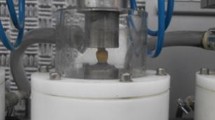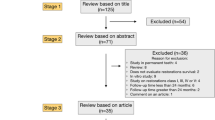Abstract
The aim of this study was to evaluate the influence of different cavity preparation designs on marginal accuracy of laboratory-processed resin composite restored teeth. Eighty mandibular human third molars were selected. There were two experimental factors, occlusal isthmus width (narrow vs wide) and cuspal coverage (inlay, one-cusp onlay, two-cusp onlay, and all-cusp onlay), resulting on eight groups (N = 10). Indirect composite restorations (SR Adoro, Ivoclar-Vivadent) were manufactured and positioned over each respective preparation. Marginal accuracy evaluation was accomplished using a stereomicroscope at three points on buccal, lingual, mesial, and distal regions with 40× magnification. The results showed significant differences (P = 0.00) with wide inlay showing the best overall marginal accuracy and narrow inlay the worst one. Two-way analysis of variance (ANOVA) showed significant differences when considering the factor occlusal isthmus width (P = 0.00). In general, preparations with wide occlusal isthmus presented better results than narrow ones, except for wide all-cusp onlays; however, the test failed to show differences when considering the cuspal coverage (P = 0.42) or the interaction between both factors (P = 0.30). The effect of occlusal width extension on marginal accuracy of indirect composite resin restorations is significant, with lower values of gaps width in wide preparations, but since in a clinical situation this would mean greater removal of sound tooth structure, less-aggressive preparations combined with other restorative procedures seem to be more feasible.




Similar content being viewed by others

References
Beschnidt SM, Strub JR (1999) Evaluation of the marginal accuracy of different all-ceramic crown systems after simulation in the artificial mouth. J Oral Rehabil 26:582–593
Burke FJ (1992) Tooth fracture in vivo and in vitro. J Dent 20:131–139
Burke FJ (1996) Fracture resistance of teeth restored with dentin-bonded crowns: the effect of increased tooth preparation. Quintessence Int 27:115–121
Burke FJ, Wilson NH, Watts DC (1993) The effect of cavity wall taper on fracture resistance of teeth restored with resin composite inlays. Oper Dent 18:230–236
Cho L, Choi J, Yi YJ, Park CJ (2004) Effect of finish line variants on marginal accuracy and fracture strength of ceramic optimized polymer/fiber-reinforced composite crowns. J Prosthet Dent 91:554–560
Cho L, Song H, Koak J, Heo S (2002) Marginal accuracy and fracture strength of ceromer/fiber-reinforced composite crowns: effect of variations in preparation design. J Prosthet Dent 88:388–395
Duke P, Moore BK, Haug SP, Andres CJ (2000) Study of the physical properties of type IV gypsum, resin-containing, and epoxy die materials. J Prosthet Dent 83:466–473
Fennis WM, Kuijs RH, Kreulen CM, Verdonschot N, Creugers NH (2004) Fatigue resistance of teeth restored with cuspal-coverage composite restorations. Int J Prosthodont 17:313–317
Ferracane JL (2005) Developing a more complete understanding of stresses produced in dental composites during polymerization. Dent Mater 21:36–42
Gemalmaz D, Ozcan M, Yoruc AB, Alkumru HN (1997) Marginal adaptation of a sintered ceramic inlay system before and after cementation. J Oral Rehabil 24:646–651
Groten M, Axmann D, Probster L, Weber H (2000) Determination of the minimum number of marginal gap measurements required for practical in-vitro testing. J Prosthet Dent 83:40–49
Hayashi M, Miura M, Nishimura N, Takeshige F, Ebisu S (2000) Effects of cavity form and setting expansion of refractory dies on adaptability of Class II (MO and MOD) fired ceramic inlays. Oper Dent 25:549–555
Holmes JR, Bayne SC, Holland GA, Sulik WD (1989) Considerations in measurement of marginal fit. J Prosthet Dent 62:405–408
Inokoshi S, Van Meerbeek B, Willems G, Lambrechts P, Braem M, Vanherle G (1992) Marginal accuracy of CAD/CAM inlays made with the original and the updated software. J Dent 20:171–177
Irie M, Suzuki K, Watts DC (2004) Marginal and flexural integrity of three classes of luting cement, with early finishing and water storage. Dent Mater 20:3–11
Jahangiri L, Wahlers C, Hittelman E, Matheson P (2005) Assessment of sensitivity and specificity of clinical evaluation of cast restoration marginal accuracy compared to stereomicroscopy. J Prosthet Dent 93:138–142
Kakaboura A, Rahiotis C, Zinelis S, Al-Dhamadi YA, Silikas N, Watts DC (2003) In vitro characterization of two laboratory-processed resin composites. Dent Mater 19:393–398
Kawai K, Isenberg BP, Leinfelder KF (1994) Effect of gap dimension on composite resin cement wear. Quintessence Int 25:53–58
Krejci I, Duc O, Dietschi D, de Campos E (2003) Marginal adaptation, retention and fracture resistance of adhesive composite restorations on devital teeth with and without posts. Oper Dent 28:127–135
Krejci I, Lutz F, Gautschi L (1994) Wear and marginal adaptation of composite resin inlays. J Prosthet Dent 72:233–244
Leinfelder KF, Isenberg BP, Essig ME (1989) A new method for generating ceramic restorations: a CAD-CAM system. J Am Dent Assoc 118:703–707
Loose M, Rosentritt M, Leibrock A, Behr M, Handel G (1998) In vitro study of fracture strength and marginal adaptation of fibre-reinforced-composite versus all ceramic fixed partial dentures. Eur J Prosthodont Restor Dent 6:55–62
Mandikos MN, McGivney GP, Davis E, Bush PJ, Carter JM (2001) A comparison of the wear resistance and hardness of indirect composite resins. J Prosthet Dent 85:386–395
McLean JW, von Fraunhofer JA (1971) The estimation of cement film thickness by an in vivo technique. Br Dent J 131:107–111
Mondelli J, Steagall L, Ishikiriama A, de Lima Navarro MF, Soares FB (1980) Fracture strength of human teeth with cavity preparations. J Prosthet Dent 43:419–422
Noack MJ, Roulet JF (1991) Tooth-colored inlays. Curr Opin Dent 1:172–178
O’Neal SJ, Miracle RL, Leinfelder KF (1993) Evaluating interfacial gaps for esthetic inlays. J Am Dent Assoc 124:48–54
Ortega VL, Pegoraro LF, Conti PC, do Valle AL, Bonfante G (2004) Evaluation of fracture resistance of endodontically treated maxillary premolars, restored with ceromer or heat-pressed ceramic inlays and fixed with dual-resin cements. J Oral Rehabil 31:393–397
Pallesen U, Qvist V (2003) Composite resin fillings and inlays. An 11-year evaluation. Clin Oral Investig 7:71–79
Peutzfeldt A, Asmussen E (2004) Determinants of in vitro gap formation of resin composites. J Dent 32:109–115
Sjogren G (1995) Marginal and internal fit of four different types of ceramic inlays after luting. An in vitro study. Acta Odontol Scand 53:24–28
Soares CJ, Martins LR, Fernandes Neto AJ, Giannini M (2003) Marginal adaptation of indirect composites and ceramic inlay systems. Oper Dent 28:689–694
Soares CJ, Martins LR, Fonseca RB, Correr-Sobrinho L, Fernandes Neto AJ (2006) Influence of cavity preparation design on fracture resistance of posterior Leucite-reinforced ceramic restorations. J Prosthet Dent 95:421–429
Soares CJ, Pizi EC, Fonseca RB, Martins LR (2005) Mechanical properties of light-cured composites polymerized with several additional post-curing methods. Oper Dent 30:389–394
Soares CJ, Soares PV, Pereira JC, Fonseca RB (2005) Surface treatment protocols in the cementation process of ceramic and laboratory-processed composite restorations: a literature review. J Esthet Restor Dent 17:224–235
Stansbury JW, Trujillo-Lemon M, Lu H, Ding X, Lin Y, Ge J (2005) Conversion-dependent shrinkage stress and strain in dental resins and composites. Dent Mater 21:56–67
Steele A, Johnson BR (1999) In vitro fracture strength of endodontically treated premolars. J Endod 25:6–8
Taylor MJ, Lynch E (1993) Marginal adaptation. J Dent 21:265–273
Thordrup M, Isidor F, Horsted-Bindslev P (1994) Comparison of marginal fit and microleakage of ceramic and composite inlays: an in vitro study. J Dent 22:147–153
Van Meerbeek B, Inokoshi S, Willems G, Noack MJ, Braem M, Lambrechts P, Roulet JF, Vanherle G (1992) Marginal adaptation of four tooth-coloured inlay systems in vivo. J Dent 20:18–26
Versluis A, Tantbirojn D, Douglas WH (1998) Do dental composites always shrink toward the light. J Dent Res 77:1435–1445
Yeo IS, Yang JH, Lee JB (2003) In vitro marginal fit of three all-ceramic crown systems. J Prosthet Dent 90:459–464
Acknowledgements
Authors are grateful to Dentsply and KG Sorensen for full donation of the materials used in this study, and to Ivoclar-Vivadent for partial donation.
Author information
Authors and Affiliations
Corresponding author
Rights and permissions
About this article
Cite this article
Fonseca, R.B., Correr-Sobrinho, L., Fernandes-Neto, A.J. et al. The influence of the cavity preparation design on marginal accuracy of laboratory-processed resin composite restorations. Clin Oral Invest 12, 53–59 (2008). https://doi.org/10.1007/s00784-007-0145-9
Received:
Accepted:
Published:
Issue Date:
DOI: https://doi.org/10.1007/s00784-007-0145-9



